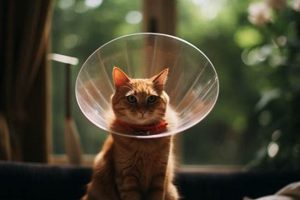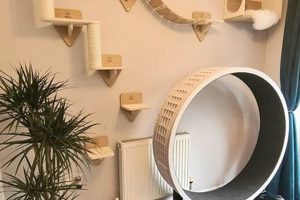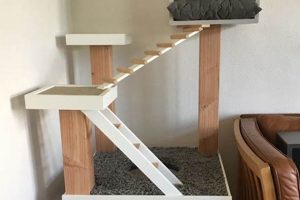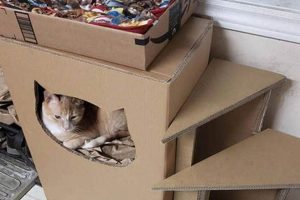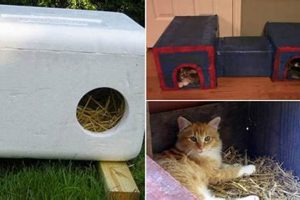A self-constructed housing designed to conceal a feline’s litter disposal area allows pet owners to integrate essential animal care components seamlessly into home decor. These constructions range from repurposed furniture to custom-built structures and serve primarily to minimize the visual impact of the litter box. Examples include modifying an old cabinet, building a small structure from wood, or adapting a storage container with an entry point.
The practice offers aesthetic advantages, reducing odors and preventing litter scatter. Historically, pet owners have sought ways to manage the less appealing aspects of pet ownership within the home. The rise of this approach reflects an increasing desire for functional and aesthetically pleasing solutions that accommodate pets needs while maintaining a clean and organized living space. Furthermore, these projects can provide a stimulating activity for pet owners.
This exploration will examine various designs, construction methods, material options, and considerations for creating these structures, focusing on functionality, aesthetics, and the well-being of the animal inhabiting the space. The subsequent sections will delve into specific types, offering detailed guidance for their creation.
Construction Considerations
The following provides guidance to ensure functionality and safety in the construction of these concealed litter areas.
Tip 1: Ventilation is Crucial: Adequate airflow prevents the build-up of ammonia and other odors. Incorporate vents or openings, especially if the structure is fully enclosed. The size and placement of vents should ensure consistent air circulation.
Tip 2: Ease of Cleaning is Paramount: Design the structure for convenient access to the litter box. Consider a hinged top, removable sides, or a sliding tray to facilitate scooping and litter replacement. A poorly designed structure will discourage regular cleaning.
Tip 3: Material Selection Affects Durability: Choose materials resistant to moisture, scratching, and odors. Solid wood, sealed plywood, or durable plastics are preferable. Avoid absorbent materials that can trap odors.
Tip 4: Entrance Size and Placement Matter: Ensure the entrance is appropriately sized for the cat and located to prevent litter tracking. The entrance should be wide enough for comfortable entry and exit, and strategically positioned to minimize litter scattering.
Tip 5: Sturdy Construction Prevents Accidents: Use secure joinery techniques and high-quality hardware to prevent collapse or instability. A flimsy structure can pose a safety hazard to the cat.
Tip 6: Consider Interior Dimensions: Provide sufficient space within the structure for the cat to comfortably move around and use the litter box. Cramped conditions may deter the cat from using the enclosure.
Tip 7: Safety First: Remove any sharp edges or potential hazards from the interior. Ensure that all materials are non-toxic and safe for animal contact.
Adhering to these recommendations can significantly improve the functionality, longevity, and safety of the structure, resulting in a more pleasant experience for both the pet and owner.
The subsequent discourse will elaborate on design options and customization strategies to further enhance the integration of these areas into various home environments.
1. Odor Control
Effective odor management is paramount in the creation of a self-constructed feline litter housing. The primary function of such an enclosure, beyond aesthetic considerations, is the mitigation of unpleasant smells associated with feline waste. Therefore, design and material choices must prioritize odor containment and neutralization.
- Ventilation Strategies
Adequate airflow is essential for dissipating odors. Incorporating ventilation, whether through strategically placed vents or permeable materials, reduces the concentration of airborne odor molecules. For instance, a design featuring open latticework or vents near the enclosure’s top facilitates the natural rise and dispersion of odors, mitigating their accumulation within the surrounding environment. Failure to adequately ventilate results in a concentrated odor presence, negating the enclosure’s intended benefits.
- Material Selection for Odor Absorption
Certain materials inherently resist odor absorption, whereas others readily trap and retain smells. Non-porous materials, such as sealed wood or durable plastics, minimize the risk of odor permeation. Conversely, untreated wood or fabrics can become saturated with odors over time, requiring replacement. The selection of appropriate materials directly impacts the long-term efficacy of odor control within the constructed area.
- Litter Type Compatibility
The chosen litter type influences the severity and nature of odors. Clumping litters, for example, facilitate the removal of solid waste, reducing the source of offensive smells. Activated carbon or zeolite-infused litters offer enhanced odor absorption capabilities. Consideration of litter compatibility is vital; an inappropriate litter choice undermines the enclosure’s capacity for odor management, irrespective of its design or materials.
- Sealing and Insulation
Ensuring a tight seal around the enclosure’s joints and seams prevents the escape of odors. Applying sealant or weather stripping minimizes air leakage, containing odors within the designated space. Insulation can further reduce odor diffusion by providing a barrier against temperature fluctuations that can exacerbate odor release. Effective sealing and insulation are critical for minimizing the pervasive spread of odors throughout the living space.
Odor control is integral to the successful implementation of a self-constructed feline litter enclosure. The integration of appropriate ventilation, material selection, litter compatibility, and sealing techniques mitigates the dissemination of undesirable odors. Prioritizing these elements contributes significantly to maintaining a hygienic and odor-free home environment, ensuring the enclosure serves its intended purpose effectively.
2. Entry Accessibility
The ease with which a feline can access its litter area significantly influences the successful utilization of a self-constructed enclosure. The dimensions, location, and design of the entry point directly impact the animals willingness to use the designated space. An entry point that is too small, located in an inconvenient position, or presents an obstacle may deter the cat from using the litter box altogether, rendering the enclosure ineffective. Conversely, a well-designed, easily navigable entrance encourages consistent usage and reinforces positive litter habits.
Consider, for example, the integration of a circular opening into the side of a repurposed cabinet. If the diameter of this opening is insufficient for the cat’s size or if the edge is sharp and uncomfortable, the animal may avoid the enclosed space. A practical application involves observing the cat’s natural movements and preferences. Does it prefer to step up, squeeze through a narrow space, or have a clear line of sight into the litter area? The entry design should align with these natural inclinations to promote comfort and minimize stress. Furthermore, multi-cat households necessitate careful consideration to ensure that the entry point does not become a source of territorial conflict.
In summary, entry accessibility is a critical component of feline litter enclosures. Overlooking this aspect can lead to behavioral issues and undermine the enclosure’s purpose. Careful planning, consideration of the cat’s individual needs, and attention to detail in the construction of the entry point are essential for ensuring the enclosure is both functional and accepted by the animal. The success of the project is inextricably linked to the feline’s ability to easily and comfortably access its litter area.
3. Material Safety
Material selection for a self-constructed feline litter housing demands rigorous attention to safety, given the animal’s constant and direct contact with the chosen components. The potential for toxic exposure, allergic reactions, or physical harm necessitates careful evaluation of all materials prior to construction.
- Toxicity of Finishes and Adhesives
Paints, stains, sealants, and adhesives often contain volatile organic compounds (VOCs) and other chemicals that can be harmful if ingested or inhaled. Opting for low-VOC or zero-VOC products is crucial in minimizing potential health risks. Ensure that all finishes are fully cured and off-gassed before the animal is allowed access to the enclosure. For example, water-based paints designed for children’s toys provide a safer alternative to solvent-based options, reducing the risk of chemical exposure.
- Suitability of Wood and Wood Composites
Certain types of wood, such as cedar or pressure-treated lumber, contain natural oils or chemical preservatives that can be toxic to felines. Solid, untreated hardwoods or formaldehyde-free plywood are preferable choices. Avoid using particleboard or medium-density fiberboard (MDF) due to their potential formaldehyde content, a known carcinogen. Careful consideration of the wood type is paramount in preventing adverse health effects.
- Potential Hazards of Plastics and Metals
Not all plastics are created equal. Bisphenol A (BPA) and phthalates, commonly found in some plastics, are endocrine disruptors and should be avoided. Opt for BPA-free plastics or, preferably, stainless steel components for trays or liners within the enclosure. Similarly, ensure that any metal hardware, such as hinges or latches, is non-corrosive and free from sharp edges to prevent injury.
- Fabric and Upholstery Considerations
If incorporating fabric elements, such as lining or cushioning, select natural, untreated materials like cotton or linen. Synthetic fabrics may contain dyes or chemical treatments that can cause allergic reactions or skin irritation. Avoid using fabrics with loose weaves or long fibers that could be ingested by the animal. Regularly inspect fabric components for wear and tear to prevent ingestion of small pieces.
The careful selection and application of materials directly impact the safety and well-being of the feline using the constructed litter area. Prioritizing non-toxic, durable, and animal-friendly components is essential in creating a safe and functional enclosure. Thorough research and adherence to safety guidelines are paramount in mitigating potential health risks associated with material choices. For instance, if budget is a factor, consider reclaimed wood from a source with verifiable safety standards.
4. Size Adequacy
Adequate dimensions are a foundational requirement for a functional self-constructed feline litter housing. The internal volume and physical dimensions of the enclosure directly affect the animal’s ability to comfortably and appropriately use the designated litter area, influencing both its physical comfort and behavioral habits.
- Internal Volume and Maneuverability
The interior space must allow the feline to turn around, dig, and position itself comfortably within the litter box. Insufficient space can lead to anxiety, avoidance of the litter box, and inappropriate elimination behaviors. For instance, a generally accepted guideline suggests the length of the enclosure should be at least 1.5 times the length of the cat, excluding its tail. Restricting these natural behaviors can result in stress and hygiene problems. This is especially critical when considering covered enclosures.
- Litter Box Dimensions and Placement
The litter box itself must fit comfortably within the enclosure, leaving adequate space around it for the cat to enter and exit without obstruction. Overcrowding the enclosure with an oversized litter box negates the intended benefits of privacy and odor control. A well-proportioned enclosure allows for easy access to the litter box while minimizing the likelihood of litter tracking. If the cat has free and unrestricted access to the litter, its habits of using that litter will improve overall, regardless of litter type.
- Entrance Height and Width Considerations
The entry point must be appropriately sized for the feline to enter and exit without discomfort or difficulty. Too small of an opening can deter use, while an excessively large opening compromises odor containment. Low-set entrances can be beneficial for older cats or those with mobility issues, whereas higher entrances may deter smaller cats. The location of the entrance, relative to the litter box, also affects ease of access and litter spillage. An ill-conceived opening, such as one directly in line with the long part of the litter container, could invite more spills than keeping the cat from going.
- Vertical Space and Psychological Comfort
While horizontal space is crucial, vertical space also contributes to the animal’s psychological comfort. Allowing enough height for the feline to stand fully erect within the enclosure, particularly in covered designs, prevents feelings of confinement and encourages regular use. Incorporating shelves or platforms within the enclosure, if space allows, can provide additional comfort and security for the cat.
Therefore, meticulous attention to dimensions is crucial when designing and constructing a concealed feline litter area. Ensuring adequate internal volume, appropriate litter box placement, accessible entry points, and sufficient vertical space is fundamental for fostering positive litter habits and promoting the animal’s well-being. The efficacy of the entire project hinges on providing a comfortable and appropriately sized environment for the feline to comfortably use the facility.
5. Cleaning Ease
Cleaning ease is a paramount consideration in the design and implementation of any self-constructed feline litter housing. The practicality and sustainability of the enclosure are directly contingent upon its ability to be efficiently and effectively cleaned. A complex or inaccessible enclosure discourages regular maintenance, leading to unsanitary conditions and potential health hazards for both the animal and its owner.
- Removable Components
The inclusion of removable trays, liners, or sections significantly simplifies the cleaning process. These components allow for the easy disposal of soiled litter and the thorough cleaning of the enclosure’s interior surfaces. For example, a design incorporating a sliding tray beneath the litter box facilitates swift removal and replacement of litter, reducing the time and effort required for routine maintenance. Such designs must also consider the weight load and material stability involved when removing the tray, especially when full.
- Accessibility of Interior Surfaces
The design should provide unimpeded access to all interior surfaces of the enclosure. Intricate corners, narrow crevices, or obstructed areas can accumulate debris and odors, making thorough cleaning difficult. Hinged tops, removable sides, or large access panels enable the user to reach and clean every part of the enclosure, ensuring optimal hygiene. The location of the access points must also be convenient for the user, preventing unnecessary strain or difficulty in reaching all surfaces.
- Material Properties and Cleanability
The choice of materials directly influences the ease with which the enclosure can be cleaned. Smooth, non-porous surfaces are easier to wipe down and disinfect than rough or absorbent materials. Selecting materials resistant to staining and odor retention further enhances cleanability. For instance, sealed wood or durable plastics can be readily cleaned with common household disinfectants, whereas untreated wood may require more specialized cleaning methods or become permanently stained. The chemical resistance of these materials must also be considered, to prevent damage when disinfecting.
- Integrated Cleaning Systems
Advanced designs may incorporate integrated cleaning systems, such as built-in spray nozzles or drainage systems, to streamline the cleaning process. These systems allow for the easy rinsing and flushing of the enclosure’s interior, reducing the need for manual scrubbing or wiping. However, the complexity and reliability of such systems must be carefully evaluated to ensure they are both effective and easy to maintain.
The correlation between cleaning ease and successful enclosure utilization is undeniable. Prioritizing cleanability in the design process promotes regular maintenance, ensuring a hygienic environment for the feline and prolonging the lifespan of the structure. Thoughtful consideration of removable components, accessibility, material properties, and integrated systems contributes significantly to the overall practicality and sustainability of the self-constructed feline litter housing.
6. Structural Integrity
The structural integrity of a self-constructed feline litter enclosure directly dictates its longevity, safety, and overall functionality. The term refers to the ability of the structure to withstand applied loads and environmental stressors without failure or deformation. A compromised structure risks collapse, posing a hazard to the animal and potentially resulting in damage to the surrounding environment. The choice of materials, joinery techniques, and overall design significantly influence the enclosure’s capacity to maintain its integrity over time. Without sufficient structural robustness, the enclosure becomes unsustainable and fails to achieve its intended purpose, regardless of aesthetic appeal or supplementary features.
Consider a scenario in which a repurposed cabinet is used as the basis for an enclosure. If the existing joints are weakened by age or moisture damage, the added weight of the litter box and the animal may cause the structure to buckle or collapse. Similarly, if the enclosure is constructed from thin or low-quality materials, such as particleboard, it may be unable to withstand the stresses of repeated use, leading to cracks, warping, and eventual failure. Practical application of structural principles involves reinforcing weak points with additional supports, using durable materials appropriate for the intended load, and employing robust joinery techniques, such as screws and adhesive, to ensure a stable and secure assembly. Furthermore, when constructing larger or more complex enclosures, internal bracing and support structures become necessary to distribute weight evenly and prevent localized stress concentrations.
In summation, structural integrity is not merely a technical detail but a fundamental requirement for a successful self-constructed feline litter enclosure. Addressing structural considerations from the outset, through careful material selection, sound design principles, and robust construction techniques, ensures a safe, durable, and functional enclosure that effectively serves its purpose. Neglecting these factors results in a short-lived and potentially hazardous structure, negating the time, effort, and resources invested in its creation. The long-term success of the project is inextricably linked to the structural soundness of the enclosure itself.
7. Ventilation
Effective ventilation is a critical component in the design and construction of a self-constructed feline litter housing. The primary function of ventilation within these enclosures is the mitigation of odor concentration and the promotion of air exchange, thereby maintaining a more hygienic and comfortable environment for both the animal and the human inhabitants of the dwelling. The absence of adequate ventilation creates a confined space where ammonia, carbon dioxide, and other volatile organic compounds emanating from feline waste accumulate, potentially leading to respiratory irritation for the animal and an unpleasant odor permeating the surrounding area. This is particularly pertinent in enclosed designs where natural air circulation is inherently limited.
Practical application of ventilation principles in these projects involves the strategic placement of vents or openings to facilitate airflow. Examples include integrating latticework panels, installing screened openings, or incorporating ventilation fans. The size and location of these vents must be carefully considered to ensure effective air exchange without compromising the enclosure’s intended function of containing litter scatter. Furthermore, the type of litter used impacts the required ventilation capacity. Litters with high ammonia production necessitate greater ventilation compared to litters with superior odor-absorbing properties. Failure to adequately ventilate not only diminishes the benefits of the enclosure but can also deter the cat from using the litter box, leading to behavioral problems.
In conclusion, ventilation is inextricably linked to the success of a self-constructed feline litter housing. The integration of appropriate ventilation strategies is essential for odor control, animal health, and the overall functionality of the structure. Challenges associated with ventilation design include balancing airflow with litter containment and aesthetic integration. However, addressing these challenges through careful planning and execution results in a cleaner, healthier, and more appealing living environment for both the pet and its owner. Therefore, any design should consider ventilation as a key success metric.
Frequently Asked Questions
The following addresses prevalent inquiries regarding the design, construction, and maintenance of self-constructed feline litter enclosures. The intent is to provide clear and concise information to facilitate informed decision-making.
Question 1: Are self-constructed feline litter enclosures truly effective at controlling odor?
Odor control efficacy varies significantly depending on design, materials, and maintenance. Enclosures incorporating adequate ventilation, non-porous materials, and regular cleaning routines demonstrate greater odor mitigation. Poorly designed or neglected enclosures may offer minimal improvement over uncovered litter boxes.
Question 2: What are the primary safety considerations when constructing a feline litter enclosure?
Material toxicity, structural integrity, and ease of access for the animal are paramount. Nontoxic finishes, sturdy construction to prevent collapse, and appropriately sized entry points are essential to ensure the animal’s safety and well-being.
Question 3: How does the size of the enclosure impact its functionality?
Insufficient space can deter the cat from using the litter box, while an excessively large enclosure may compromise odor control and cleaning ease. The enclosure should provide ample room for the animal to turn around, dig, and eliminate comfortably, while also accommodating the litter box itself.
Question 4: What materials are most suitable for constructing a durable and hygienic feline litter enclosure?
Sealed wood, durable plastics, and stainless steel are generally recommended for their moisture resistance, ease of cleaning, and longevity. Absorbent materials, such as untreated wood or fabric, should be avoided due to their propensity for odor retention and bacterial growth.
Question 5: How frequently should a self-constructed feline litter enclosure be cleaned?
Cleaning frequency depends on the number of cats, the type of litter used, and the design of the enclosure. As a general guideline, the litter box should be scooped daily, and the entire enclosure should be thoroughly cleaned and disinfected at least once a month.
Question 6: Can a self-constructed feline litter enclosure be effectively integrated into various home decor styles?
Aesthetic integration is achievable through careful design and material selection. Enclosures can be disguised as furniture, painted to match existing decor, or constructed from materials that complement the overall style of the home. Discreet placement and thoughtful design are key to seamless integration.
In summation, the successful implementation of these projects hinges on careful planning, attention to detail, and a thorough understanding of feline behavior and hygiene requirements.
The subsequent section will explore advanced design concepts and customization options for self-constructed feline litter enclosures.
Conclusion
This exploration of “diy cat box enclosure” reveals the multifaceted considerations involved in their successful creation. Key aspects encompass odor control, animal safety, ease of cleaning, structural integrity, ventilation, and size adequacy. Attentiveness to these elements is paramount for both functionality and the well-being of the animal utilizing the structure.
The pursuit of a well-designed “diy cat box enclosure” represents a commitment to responsible pet ownership and thoughtful home integration. Continued innovation in design and material selection will undoubtedly refine these solutions, fostering enhanced living environments for both pets and their human companions. Prioritizing animal welfare alongside aesthetic considerations remains central to the ongoing evolution of these projects.


